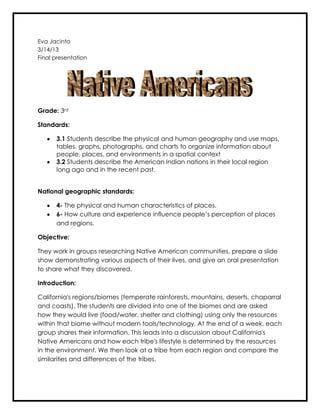
Native american lesson plan
- 1. Eva Jacinto 3/14/13 Final presentation Grade: 3rd Standards: 3.1 Students describe the physical and human geography and use maps, tables, graphs, photographs, and charts to organize information about people, places, and environments in a spatial context 3.2 Students describe the American Indian nations in their local region long ago and in the recent past. National geographic standards: 4- The physical and human characteristics of places. 6- How culture and experience influence people’s perception of places and regions. Objective: They work in groups researching Native American communities, prepare a slide show demonstrating various aspects of their lives, and give an oral presentation to share what they discovered. Introduction: California's regions/biomes (temperate rainforests, mountains, deserts, chaparral and coasts). The students are divided into one of the biomes and are asked how they would live (food/water, shelter and clothing) using only the resources within that biome without modern tools/technology. At the end of a week, each group shares their information. This leads into a discussion about California's Native Americans and how each tribe's lifestyle is determined by the resources in the environment. We then look at a tribe from each region and compare the similarities and differences of the tribes.
- 2. Procedure: Divide the students into groups and give them an outline/questionnaire of what they should be focusing on during the research: How did families live without modern houses? How did they get their food? What did they do if they were injured? Sick? How did they get the water? How they protected themselves? After the research students will present in class what they each learned about their tribe. As a class we’ll answer the following questions: What did we learn from our Native American friends? How did their environment influence their way of life? What they wore, ate, how they traveled, shelter structures Did all the tribes have a belief in common? How did they communicate? What games did they play? Where is your tribe today and what are they doing? Tools: Computer (for web research about the tribe). Books. Follow up activity: Indian Canyons field trip.